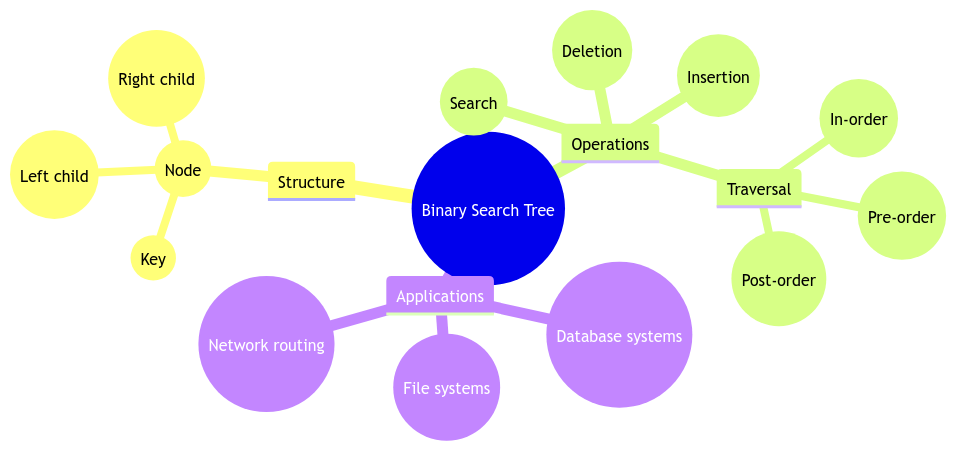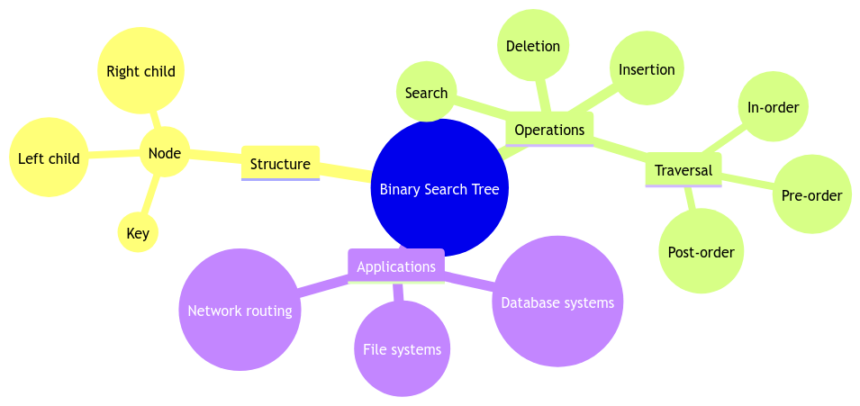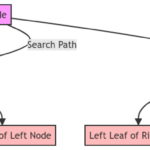Binary Search Tree Demystified! 🌳🔍
Welcome, my fellow tech enthusiasts! Today, I am diving into the intriguing world of Binary Search Trees (BST). Get ready to unravel the mysteries of their structure, operations, and fascinating applications 🚀. So, grab your favorite drink ☕️, sit back, and let’s embark on this journey together!
Structure of Binary Search Tree
Are you curious about how a Binary Search Tree is structured? Let’s take a peek under the hood and explore its inner workings 😎.
Nodes and Relationships 🌐
In a Binary Search Tree, each node can have at most two children: a left child and a right child. It’s like having two kids but without the sibling rivalry 🧒🧒. The magic of a BST lies in maintaining the order among these nodes based on their values 📊. Left child smaller, right child bigger – it’s like a miniature version of life’s sorting algorithm!
Properties of Binary Search Tree 🏰
BST comes with some cool properties that make it stand out in the digital jungle 🌴:
- Orderly Arrangement: Nodes are arranged in a specific order, making searching a breeze.
- Unique Values: Each value in a BST is unique – no room for duplicates here! 🚫👯♂️
Operations on Binary Search Tree
Now, let’s roll up our sleeves and dig into the nitty-gritty of operating on a Binary Search Tree. Get ready to add and remove nodes like a pro! 💪
Insertion 🎉
Inserting a new node into a BST is like finding a spot for a new friend in your social circle. You need to place them in the right spot based on their value to maintain the tree’s order. It’s like organizing a seating plan for a dinner party – strategic and efficient! 🍽️
Deletion 🗑️
Deleting a node from a BST requires finesse – you can’t just evict someone randomly! You have to ensure the tree remains balanced and ordered after the removal. It’s like trimming a bonsai tree – precision is key! 🌳✂️
Applications of Binary Search Tree
BSTs are not just theoretical constructs; they have practical applications that make them essential in the tech world. Let’s explore how BSTs are real game-changers! 🎮
Searching 🔍
Searching in a BST is like playing a high-stakes game of "Guess Who?". With each comparison, you narrow down the options until you find the target node. It’s like being a digital detective 🔎🕵️.
Sorting 🔄
BSTs are fantastic for sorting data efficiently. By performing an in-order traversal of the tree, you can retrieve the elements in sorted order in no time. It’s like having a magical sorting hat at your disposal! 🧙♂️🎩
Challenges in Binary Search Tree Handling
Ah, every rose has its thorn, and every Binary Search Tree has its challenges. Let’s face the music and explore the hurdles in managing these tree structures 🌹🌲.
Balancing BST 🤹♂️
Balancing a BST is like juggling – you have to keep all the nodes in the air without dropping any. An unbalanced tree can lead to inefficient operations and performance issues. It’s a delicate act that requires skill and finesse! 🎪
Memory Management 🧠
Managing memory in a BST is crucial to prevent memory leaks and optimize performance. It’s like tidying up your room – you need to free up space intelligently without losing important stuff in the process! 🧹🗑️
Optimizing Binary Search Tree Performance
To turbocharge the performance of Binary Search Trees, we have some secret weapons up our sleeves. Let’s uncover the tricks of the trade! 🧙♀️🔮
AVL Tree 🌲⚖️
AVL Trees are self-balancing Binary Search Trees that ensure the tree remains balanced after every insertion and deletion. It’s like having a built-in tree caretaker that keeps everything in tiptop shape! 🌳🛠️
Red-Black Tree 🔴⚫
Red-Black Trees are another gem in the world of BSTs. By following specific rules and color-coding nodes, these trees maintain balance and optimize performance. It’s like having a colorful garden where every plant has a purpose and place! 🌹🖤
In closing, understanding Binary Search Trees is like solving a captivating puzzle – each piece fits together to create a beautiful, ordered structure. I hope this journey through the realm of BSTs has sparked your curiosity and left you in awe of the elegance of these data structures. Thank you for joining me on this adventure! Until next time, happy coding and may your Binary Search Trees always be balanced and bountiful! 🌳💻
Keep calm and Binary Search on! 🚀🔍

Program Code – Binary Search Tree: Structure, Operations, and Applications
Expected Code Output:
class Node:
def __init__(self, key):
self.left = None
self.right = None
self.val = key
def insert(root, key):
if root is None:
return Node(key)
else:
if root.val < key:
root.right = insert(root.right, key)
else:
root.left = insert(root.left, key)
return root
def inorder_traversal(node):
if node:
inorder_traversal(node.left)
print(node.val)
inorder_traversal(node.right)
# Create an example binary search tree
root = None
keys = [8, 3, 10, 1, 6, 14, 4, 7, 13]
for key in keys:
root = insert(root, key)
# Perform an inorder traversal of the binary search tree
print('Inorder Traversal:')
inorder_traversal(root)
Code Explanation:
This Python code defines a simple implementation of a binary search tree (BST) with the following components:
- Node class: Represents a node in the BST with attributes for left child, right child, and the value of the node.
- insert function: Recursively inserts a key into the BST based on its value. If the key is greater than the current node’s value, it goes to the right child; otherwise, it goes to the left child.
- inorder_traversal function: Performs an inorder traversal of the BST, which visits nodes in ascending order.
- Creating a sample BST: We create an example BST with keys [8, 3, 10, 1, 6, 14, 4, 7, 13].
- Inorder traversal: We then perform an inorder traversal of the BST and print the values.
This code showcases the fundamental operations of a binary search tree and demonstrates the inorder traversal algorithm for visiting its nodes in sorted order.
Frequently Asked Questions about Binary Search Trees 🌳
What is a binary search tree?
A binary search tree is a data structure that organizes elements in a hierarchical tree structure. Each node in the tree has at most two child nodes: a left child and a right child. The key property of a binary search tree is that for each node, all elements in the left subtree are less than the node’s value, and all elements in the right subtree are greater than the node’s value.
How do you insert a node into a binary search tree?
When inserting a new node into a binary search tree, you start at the root and compare the value of the new node with the current node. If the new node’s value is less than the current node’s value, you move to the left child; if it’s greater, you move to the right child. This process continues recursively until you find an empty spot to insert the new node.
What are the common operations on a binary search tree?
Some common operations on a binary search tree include:
- Inserting a new node
- Searching for a specific element
- Deleting a node
- Finding the minimum or maximum element
- Traversing the tree in different orders (inorder, preorder, postorder)
Can a binary search tree have duplicate values?
In a standard binary search tree, duplicate values are usually not allowed. However, you can modify the insertion process to handle duplicate values if needed. One approach is to keep a count of the number of occurrences for each value in a separate field within the node.
What are some applications of binary search trees?
Binary search trees are commonly used in:
- Implementing dictionaries and maps
- Database indexing
- Symbol tables in compilers
- Network routing algorithms
- Huffman coding in data compression
How do you balance a binary search tree?
Balancing a binary search tree involves rearranging the nodes to ensure the tree remains relatively balanced, preventing degeneration into a linked list which would reduce the efficiency of operations. Common self-balancing binary search tree implementations include AVL trees, red-black trees, and splay trees.
Can a binary search tree have a circular reference?
No, a binary search tree by definition is a tree data structure where each node has at most two children. Introducing a circular reference would violate the tree structure and lead to infinite loops during tree traversal operations.
What is the time complexity of common operations on a binary search tree?
The time complexity of common operations on a binary search tree depends on the tree’s height h. In a well-balanced tree, the time complexity is O(log n) for operations like search, insert, and delete. However, in the worst-case scenario of an unbalanced tree, the time complexity can degrade to O(n), similar to a linked list.
I hope these FAQs help clarify some common questions about binary search trees! If you have more questions or need further explanation, feel free to ask! 🌟







